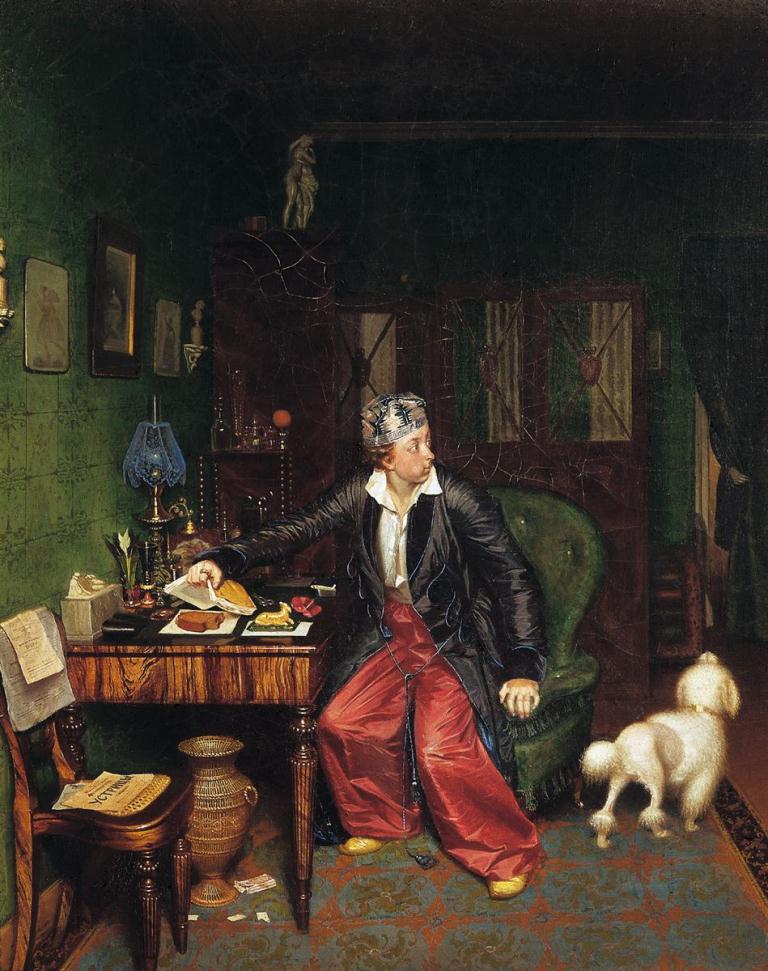If in the work “The Major’s Courtship” the frame of the picture imitates the portal of the scene, as if we were observing what is happening from the stalls, then in the “Breakfast of an Aristocrat” the interior is shown as the scene is perceived from behind the curtains: we see exactly what is hiding from the entrance … The comic situation here is of the same kind that is expressed in the theatrical jargon by the concept of “overlay”: something “from another opera” or from real life is superimposed on the artistically deliberate, so that the intentional and the unintentional form a willful paradoxical unity. In this case, such an artificial staging is the “theater of things” in the interior of the room. Things here represent not their everyday purpose, but the image of a “beautiful life”, this purpose discredits: you cannot sit on a chair – posters of fashionable restaurants are displayed on it – pieces of cut paper on the carpet next to the basket show exactly that such a basket is in the form of a narrow-necked vessel not adapted for what it was actually set up for. She is here not at all to serve as a container for garbage, but to demonstrate the noble shape of an antique amphora, and mainly the noble taste of the owner. The paper was obviously cut so that on a shining blank sheet of the required size the newly acquired statuette would immediately catch the eye of the incoming person. But next to it, a bitten crust of black bread lay on another part of the same sheet, thus assuming the same character of a showpiece as the other “beautiful things.” It is this “overlay” that the host tries to close from the incoming guest.
But in this case Fedotov uses the theme of “show-off life” not so much in the interests of “criticism of morals” as “in the interests of painting”: after all, everything ostentatious that characterizes the manners of the hero of the picture – a carpet, an armchair, knick-knacks on the table, all the furnishings of this room have aesthetic merits. For a painter, for his eye, this window dressing makes up a fascinating coloristic ensemble and allows him to demonstrate his skill and love for object charm, regardless of the ridicule that the situation of the picture itself can cause. To indicate this comic incident, it would be enough just a piece of bread next to the statuette, covered with a book. In terms of the nobility of the composition, the brilliance of the performing skills, Breakfast surpasses all the previous paintings by Fedotov – none of them was such an exquisite color ensemble, such a textured variety, such an increased sensitivity to complex and rare color harmonies (a combination of blue and green, for example). The accuracy of perspective angles (in the pose of the owner who has risen from the chair and the poodle turned in the depths), the characteristic of various textured qualities of reproduced things (transparent, fleecy, soft, hard, shiny, matte, etc.) – the skill of solving these problems is comparable to the best examples of world painting. The degree of compositional and pictorial sophistication for an artist who turned to painting only three years ago is incredible.
In this work, perhaps the main contradiction of Fedotov’s painting is sharpened. The fact is that within the plots dedicated to everyday absurdities, the situation and the whole world around them characterize the characters depicted, their tastes and preferences. But they cannot coincide with the taste of the artist himself, since here the author and the heroes are separated by an ironic distance. And now Fedotov has reached that degree of pictorial mastery that awakens a natural thirst to reiterate his sense of beauty and understanding of beauty directly, bypassing this distance. But as long as the old plot program remains, this distance must somehow be curtailed, reduced. In the painting “Not at the Time of the Guest” this is expressed in the fact that the comic of the incident, in contrast to previous works, is reduced to an anecdote, “rolled to a point”, is clear at first glance. And the time of contemplation of the picture as a pictorial creation unfolds not in the sphere of this comic, but in the sphere of admiring the beauty of the pictorial ensemble presented to us, regardless of the satirical tasks of the plot.
Year of painting: 1850.
Dimensions of the painting: 51 x 42 cm.
Material: canvas.
Writing technique: oil.
Genre: genre painting.
Style: realism.
Gallery: State Tretyakov Gallery, Moscow, Russia.
